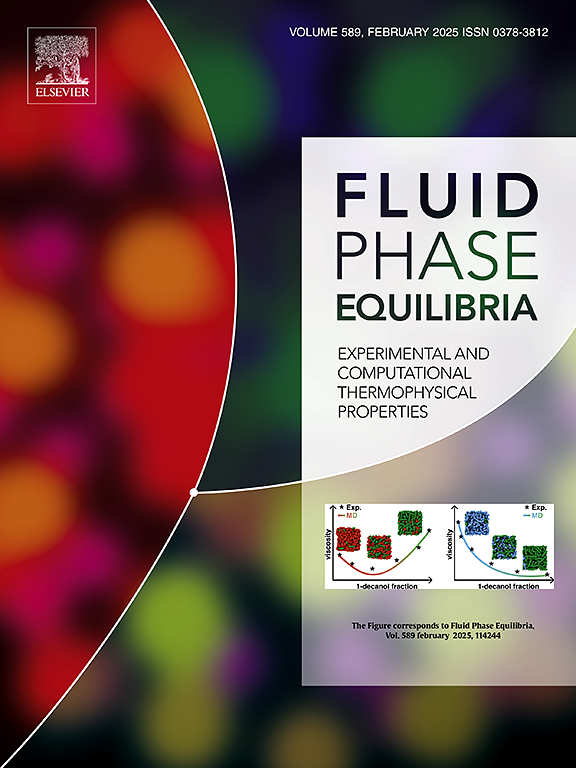Data-driven extended corresponding state approach for residual property prediction of hydrofluoroolefins
IF 2.7
3区 工程技术
Q3 CHEMISTRY, PHYSICAL
引用次数: 0
Abstract
Hydrofluoroolefins are considered the most promising next-generation refrigerants due to their extremely low global warming potential values, which can effectively mitigate the global warming effect. However, the lack of reliable thermodynamic data hinders the discovery and application of newer and superior hydrofluoroolefin refrigerants. In this work, integrating the strengths of theoretical method and data-driven method, we proposed a neural network extended corresponding state model to predict the residual thermodynamic properties of hydrofluoroolefin refrigerants. The innovation is that the fluids are characterized through their microscopic molecular structures by the inclusion of graph neural network module and the specialized design of model architecture to enhance its generalization ability. The proposed model is trained using the highly accurate data of available known fluids, and evaluated via the leave-one-out cross-validation method. Compared to conventional extended corresponding state models or cubic equation of state, the proposed model shows significantly improved accuracy for density and energy properties in liquid and supercritical regions, with average absolute deviation of 1.49 % (liquid) and 2.42 % (supercritical) for density, 3.37 % and 2.50 % for residual entropy, 1.85 % and 1.34 % for residual enthalpy. These results demonstrate the effectiveness of embedding physics knowledge into the machine learning model. The proposed neural network extended corresponding state model is expected to significantly accelerate the discovery of novel hydrofluoroolefin refrigerants.
数据驱动的扩展对应态法用于氢氟烯烃剩余物性预测
氢氟烯烃因其极低的全球变暖潜能值而被认为是最有前途的下一代制冷剂,可以有效地缓解全球变暖效应。然而,缺乏可靠的热力学数据阻碍了更新和更好的氢氟烯烃制冷剂的发现和应用。本文结合理论方法和数据驱动方法的优势,提出了一种神经网络扩展的对应状态模型来预测氢氟烯烃制冷剂的剩余热力学性质。创新之处在于,通过引入图神经网络模块和模型架构的专业化设计,通过微观分子结构来表征流体,增强了模型的泛化能力。该模型使用已知流体的高精度数据进行训练,并通过留一交叉验证方法进行评估。与传统的扩展对应状态模型或三次状态方程相比,该模型对液体和超临界区域的密度和能量特性的平均绝对偏差显著提高,密度(液体)和能量特性的平均绝对偏差为1.49%(液体)和2.42%(超临界),剩余熵的平均绝对偏差为3.37%和2.50%,剩余焓的平均绝对偏差为1.85%和1.34%。这些结果证明了将物理知识嵌入到机器学习模型中的有效性。所提出的神经网络扩展对应状态模型有望显著加快新型氢氟烯烃制冷剂的发现。
本文章由计算机程序翻译,如有差异,请以英文原文为准。
求助全文
约1分钟内获得全文
求助全文
来源期刊

Fluid Phase Equilibria
工程技术-工程:化工
CiteScore
5.30
自引率
15.40%
发文量
223
审稿时长
53 days
期刊介绍:
Fluid Phase Equilibria publishes high-quality papers dealing with experimental, theoretical, and applied research related to equilibrium and transport properties of fluids, solids, and interfaces. Subjects of interest include physical/phase and chemical equilibria; equilibrium and nonequilibrium thermophysical properties; fundamental thermodynamic relations; and stability. The systems central to the journal include pure substances and mixtures of organic and inorganic materials, including polymers, biochemicals, and surfactants with sufficient characterization of composition and purity for the results to be reproduced. Alloys are of interest only when thermodynamic studies are included, purely material studies will not be considered. In all cases, authors are expected to provide physical or chemical interpretations of the results.
Experimental research can include measurements under all conditions of temperature, pressure, and composition, including critical and supercritical. Measurements are to be associated with systems and conditions of fundamental or applied interest, and may not be only a collection of routine data, such as physical property or solubility measurements at limited pressures and temperatures close to ambient, or surfactant studies focussed strictly on micellisation or micelle structure. Papers reporting common data must be accompanied by new physical insights and/or contemporary or new theory or techniques.
 求助内容:
求助内容: 应助结果提醒方式:
应助结果提醒方式:


